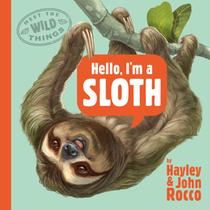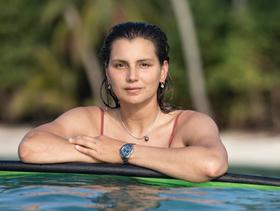
|

|
Maya Gabeira is the two-time world record holder Brazilian big-wave surfer, best known for surfing the biggest wave ever--73.5 feet--by a woman. Gabeira, an Oceana ambassador and a UNESCO Champion of the Ocean and Youth, is passionately committed to restoring the world's oceans. She is the author of the picture books Maya and the Beast and Maya Makes Waves, (illustrated by Ramona Kaulitzki; Abrams).
Hayley Rocco is the author of How to Send a Hug, as well as Wild Places, Hello, I'm a Pangolin, and Hello, I'm a Sloth (illustrated by John Rocco; Putnam). Rocco, co-founder of Children's Book Creators for Conservation and an ambassador for Wild Tomorrow, a nonprofit focused on conservation and rewilding South Africa, travels the world armed with a pen, a journal, and her camera, discovering stories of wild things and wild places.
Here, Rocco and Gabeira discuss authoring picture books about nature and conservation and discuss wildlife, fascinating animals, and their shared goal of getting children invested in conservation.
Hayley Rocco: Hi Maya, I'm so excited to talk to you! How did you get into conservation?
Maya Gabeira: My passion for conservation started when I was a child. My dad is a politician and activist who was talking about climate change before I was even born. I grew up understanding that nature was being destroyed and ocean animals were endangered.
When I started surfing, I witnessed firsthand the devastation in our oceans--coral bleaching, plastic pollution. As I got older, I began to dig into science reports and started accessing data through my work with Oceana and UNESCO. At first, I was in a small role, lending my voice to causes and to the organization as a whole. As my professional and athletic career grew, I decided it was time to take a bigger role in ocean conservation. Fifteen years later, I'm on the board of directors at Oceana and joining UNESCO's Ocean Decade initiative, all while communicating the science that needs to reach stakeholders, lawmakers, and society. This work has fueled my passion as a children's book author, aiming to inspire the next generation to protect our oceans.

|
|
| Maya Gabeira (photo: Ana Catarina) |
|
Rocco: That's exactly what we have in common! I'm writing a series called Meet the Wild Things, where endangered species introduce themselves to young readers, ages 3 to 7. The hope is to get kids to connect with the animals. If that relationship is built, they will hopefully care about their environment and work to protect it as they get older. It's a lofty goal, to get them to care more about the wild and their future.
Gabeira: That sounds amazing. What are some of the animals you write about in your books?
Rocco: Well, the first is about pangolins because they are the most trafficked animal in the world, but they are also adorable. I fell in love with them when I was doing research for Wild Places, a book about David Attenborough and how the world has changed in his lifetime. The second book in Meet the Wild Things is all about sloths. In the books, the animals tell the reader fun facts about themselves, but they also explain why they're in danger, what people are doing to aid their protection, and how kiddos can help. I think the big disconnect for me when I was younger and learning about climate change was that I didn't know how I could help.
Gabeira: You were in a good school if they were teaching about climate change! When I went to school, I never heard that term. It was only later in life as an adult that I started to learn about it.
 |
|
| Hayley Rocco | |
Rocco: I mean, at that point, they were still calling it global warming! But it was a thing scientists dealt with, right? I knew I would never be that person. So, as a children's book author, I want to connect young readers with the conservation world as best I can.
I started an organization with my husband and illustrator, John Rocco, called Children's Book Creators for Conservation; we went on a trip with Wild Tomorrow, a charity that's all about restoring wildlife in KwaZulu-Natal, South Africa, one of the most biodiverse spots in the world. I was awestruck by the efforts these conservation warriors were making.
Gabeira: It sounds like your organization is doing important work! When I was starting to write Maya Makes Waves, I had this idea of creating a call to action. I wanted to do something that would invite readers to make an impact in the world. I hope to inspire young readers to use their voices in different ways to represent the animals and the ocean, like you are doing with your organization.
Rocco: You're using your work to give a voice to the oceans and presenting reasons for kids to care more about the planet.
Okay, I have a question I've been wondering about: Do you have any stories of experiences with animals while surfing?
Gabeira: Yes! One time in South Africa, I was surfing a big wave break and as I was paddling on my board, I saw a huge whale underneath us. It was shocking! A huge wave broke over the whale and then it disappeared completely--never to be seen again. I was awestruck by the size and power of the whale in its element.
Another time, while surfing in Hawaii, it was late afternoon in an area famous for big waves, and a storm was approaching fast! Trying to swim back, I was caught in a strong current in the bay, and I struggled to reach safety. With the sky turning black and lifeguards shouting warnings, panic set in. Then, a turtle popped its head out of the water beside me. Instantly, I felt calm. I followed the turtle back, and it guided me safely to shore. These experiences with animals in their element are truly humbling.
Rocco: That's incredible!
Gabeira: I put that story in the book to show how smart the turtle was about currents. What other animals are going to be in your series?
Rocco: There are six books coming out. It's starting with sloth and pangolin, and the next book (which comes out in September) is all about the quokka. Then the axolotl is next in March!
I heard that one of your favorite places to surf is in Indonesia--have you heard of the pygmy slow loris?
Gabeira: I have not.
Rocco: That's one of the animals that I'm writing about now! They're small nocturnal primates with big buggy eyes and are the only primate scientists know about that is venomous. They're deadly--pygmy slow lorises put their venom on their teeth when they bite their prey.
Gabeira: What an interesting animal.
Rocco: Right? So, hopefully our picture books will reach and inspire young people.
Gabeira: I hope so. I really want to connect children to the ocean.
Rocco: Absolutely--anything we can do, right?

